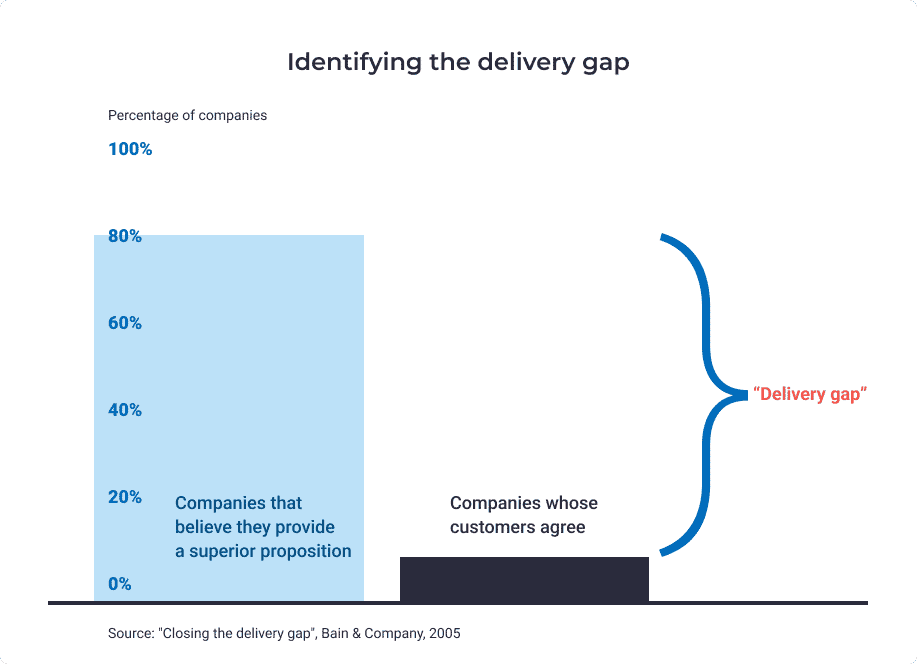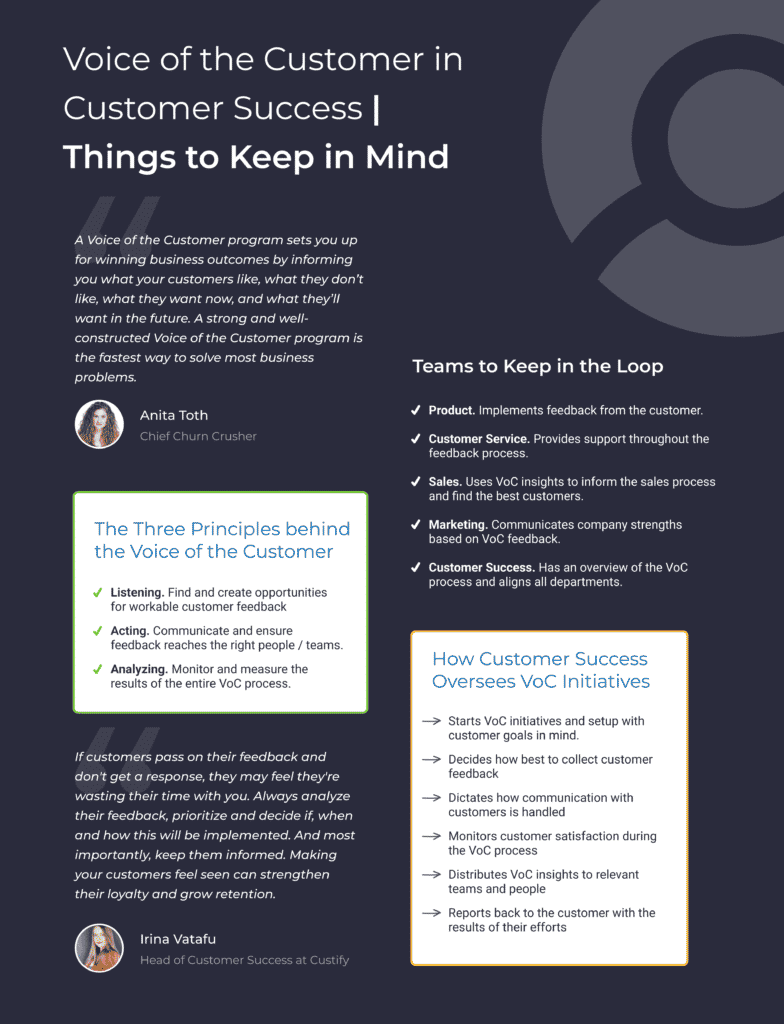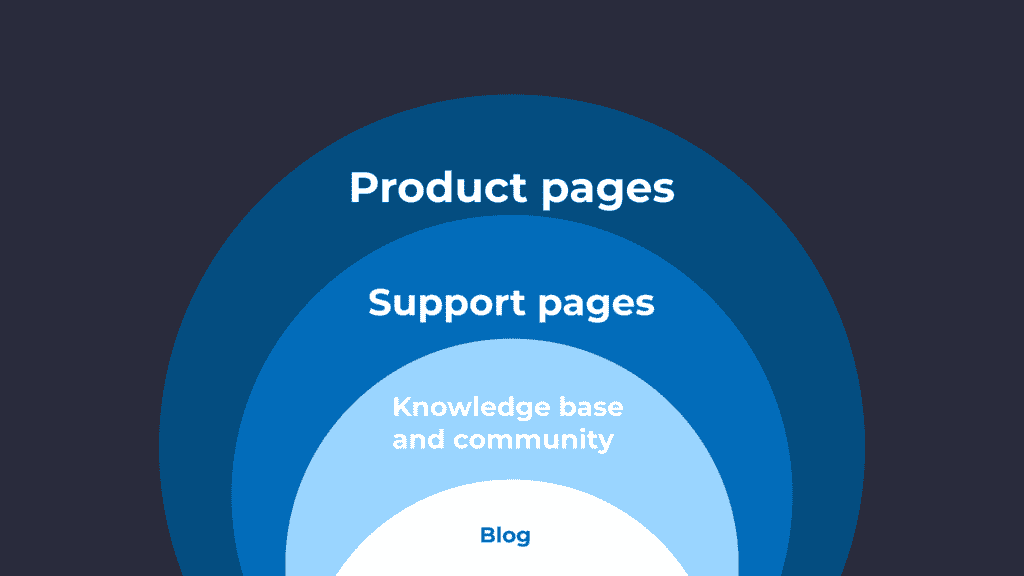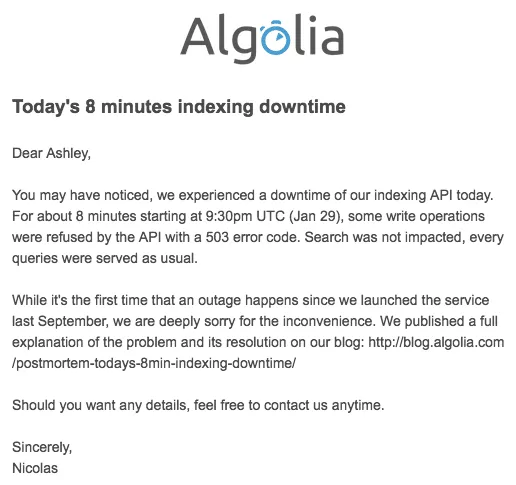Through Voice of the Customer, or VoC, programs, the business world opens itself up to direct customer feedback.
While all serious companies collect and utilize feedback from their clients, VoC programs allow you to kick things up a notch by facilitating direct improvements to the product.
Have you ever wanted to truly listen to a customer’s complaint instead of waiting for a set number to be met before taking action? VoC is your chance to do that and focus on individual feedback.
Why the Customer’s Voice Is Important
Helping businesses listen to their customers was a part of Custify’s mission from the start. But as you can see in the Bain & Company graphic here, there’s a big disconnect there. Most customers disagree with companies that say their propositions are superior to their competitors.
This means 80% of companies in this study likely never had a Voice of the Customer program, or it wasn’t very effective.
Here’s why it’s important to listen to your customers’ voice:
- It ensures there’s no disconnect or disagreement on service / product quality between company and customer perception.
- Customers expect you to listen to them, increasingly so based on evolving customer experience trends, and will likely pay more for your product / service if you do.
- It’s still easy to be better than your competitors. The pandemic accelerated the evolution of customer expectations to a point where CX as a whole is being reimagined. In that context, many companies are losing business because of their lack of flexibility and inability to adapt. By listening to your customers directly, you’ll stand out in the crowd and establish yourself as a great company to partner with.
Defining Voice of the Customer
Voice of the Customer (VoC) is a process by which a company gathers and understands feedback from their customers, and then uses it to directly push product changes, fixes, optimizations, and features.

VoC can be broken down into three main tenets:
- Listening. Finding and creating opportunities for highly-specific and workable customer feedback that can inform product changes and business goals.
- Acting. Communicating with customers, ensuring their feedback is heard and transferred to the relevant teams, and following up after the fact.
- Analyzing. Reviewing the results of individual interactions and the overall VoC process, focusing on success in attaining customers’ goals.
By setting up VoC, businesses create a clear, step-by-step process involving these three philosophies and looping in all the relevant departments such as:
- Product. The team responsible for implementing customer feedback – they must use VoC to inform their priorities when updating the product or service.
- Customer Service. The team reassures customers and provides support throughout the resolution process. Often, customer service is the department that actively listens for VoC insights.
- Sales. The team that can use those VoC insights to sell to potential customers that would get the most value out of the product or service.
- Marketing. The team constantly aligns promotional messaging with product strengths based on customer feedback, thus bringing in MQLs that are a better fit for the business.
- Customer Success. The team that has an overview of the entire process, aligns all the other departments with the voice of the customer and communicates with customers directly about their feedback.
Other departments are occasionally involved with the voice of the customer. Most notably, management is often CCed just so C-suite stakeholders have an accurate picture of customer needs and wants.
How Customer Success Can Oversee Voice of the Customer
Customer success has the most significant impact on VoC initiatives:
- First of all, it’s the customer success department that typically begins a Voice of the Customer process. CSMs must ensure everything is set up properly and with customer goals in mind.
- Secondly, CS teams decide how to collect actionable customer feedback and oversee customer communication to gather the most relevant insights. CS also ensures customers feel happy and heard throughout the feedback-gathering part.
- Third, customer success is responsible for distributing VoC feedback to relevant stakeholders and setting up a process by which that feedback is actually used to improve the product or service and help customers towards their goals.
- Lastly, but probably most importantly, CS also closes the VoC loop by reporting back to the customer once their feedback has been reviewed and, in the ideal scenario, implemented.
It’s not easy to decide which customers to prioritize when reviewing feedback. Ideally, CS teams should aim to help the best-fit accounts, the most prominent ones, or those with the biggest potential (upsell or otherwise).
However, product, customer service, and sales will all have opinions about this decision. Listening to both the customers and the internal teams in order to make a calculated decision is not just a best practice, it’s the responsibility of any good CSM.
A Voice of the Customer program sets you up for winning business outcomes by informing you what your customers like, what they don’t like, what they want now, and what they’ll want in the future. A strong and well-constructed Voice of the Customer program is the fastest way to solve most business problems.
Voice of the Customer Methodologies – Essential Techniques for Gathering Customer Feedback
95% of consumers believe customer service is essential for brand loyalty, and you can’t have good customer service without practiced, informed listening.
It’s rare that over 90% of consumers agree on anything, so being better at listening isn’t just the first step towards VoC, it’s also a way to ensure your entire business is more aligned with customers’ needs and wants. Listening is also one of the three core principles behind the Voice of the Customer.

Here are the best techniques to gather customer feedback in an intelligent, success-focused manner:
1. Ask your customer(s) directly. Working based on customer personas, find the customers that would be ideal for your VoC initiative. Then proceed to ask them directly on the channel they use most frequently to communicate with you.
2. Set up customer interviews. With interviews, you’re taking it one step further and making it more official. The upside is your customers will see how official these interviews are and understand how much you value their opinion, but as a downside, they may be wary of an overlong process.
3. Gather feedback through surveys. There are many types of surveys and ways in which you can present them:
- You could create long, complex customer surveys on a recurring schedule (monthly, quarterly, yearly, etc.). These surveys are perfect if you need a good overview of your entire customer base.
- You could add contextual surveys within the product – those are great for hyper-specific feedback. Not sure about the usefulness of a new product feature? Set a customer feedback survey right next to it with 1-2 questions.
- Or simply go for in-person surveys. If your team spends a lot of time on calls or face-to-face meetings with customers, that’s a great place to pose a survey directly. Often, your customers will be caught off guard and might provide more honest answers than they would in written form.
4. Use live chat to encourage conversations. Creating a safe space for conversations – even if you switch to Slack – is a way to guarantee the quality of the feedback you receive. Remind your customers of the live chat function regularly, and in time they’ll feel at ease starting a conversation there.
5. Monitor online mentions and reviews. One of the best and sadly-overlooked indirect methods of gathering feedback, online mentions excel on an honesty level. After all, people tend to have no filter in online reviews and comments sections.
6. Keep track of customer data and behavior. Using powerful account overview tools like our Customer 360 feature, you can gather customer feedback without ever asking your customers anything. By researching your accounts, identifying patterns, and correlating them with the product or service, you’re already starting a fantastic voice of the customer program.
7. Use traditional metrics like NPS and CSAT. Classic customer feedback surveys are still great at providing some high-level insights. To make them more specific and valuable for VoC, consider adding a second question along the lines of “How could we make that score better?”
8. Record customer calls and review them. Besides asking directly in your calls, you can also have everyone on your team record their meetings. You can then review the recordings and scan for potential VoC insights.
9. Ask multiple clients through a focus group. Last but certainly one of the methods with the most potential, focus groups have a way of making everyone talk about everything they dislike. This might be the most brutally honest way of gathering feedback, so you should prepare yourself and your team for that possibility.
Examples of VoC Questions
Finding the right questions to ask can also be tricky. In this next section, we’ve put together 20 questions typically posed to customers. You can review them and use one or come up with your own based on these. Think of it as inspiration:
- On a scale of 0 to 10, how likely are you to recommend our company / product / service / website to a friend or colleague? (NPS)
- What’s the first thing that comes to mind when you think of our company / product / service?
- Based on your most recent purchase / renewal / upgrade / customer service interaction, how likely are you to recommend us?
- How can we improve your experience with our company / product / service / website?
- Did you encounter any difficulties in using our product / service / website?
- Did you achieve what you set out to do with our product / service / website today?
- What’s one feature of our competitors that you’d like to see implemented in our product / service / website?
- How satisfied are you with our company / product / service / website? (CSAT)
- What do you value most when choosing a company you’ll do business with?
- What matters most to you if you’re looking for a product / service / website in our niche?
- What company have you done the most business with over the last year?
- Can you name four other companies of the same type as ours?
- If you were to pick one of our competitors, who would you choose and why?
- What type of customers would most benefit from our product / service / website?
- What five words would you use to describe our company / product / service / website?
- What’s one feature of our product / service / website that you had difficulty understanding?
- A business acquaintance asks you to recommend a product / service / website like ours. What do you say?
- What’s one personal work goal that we can help you with?
- What’s one business / product / service / website issue that would cause you to stop doing business with us?
- What’s one social issue that would make you stop patronizing a business?
How to Use Voice of the Customer to Drive Loyalty and Retention
Using the methodologies above, you can quickly have a Voice of the Customer program ready and set. That’s all it takes for it to start bringing in value.
Data-led changes and optimizations will only serve to drive ROI and keep it relevant to the business. To aid in that, consider following some or all of the following advice meant to increase retention, build loyalty, and improve ROI.
Encouraging customers to provide feedback is a common practice in any SaaS company, as we absolutely need their valuable opinions to make the product even more user-friendly, intuitive and useful. But like any other process, this one must also have an outcome. If they pass on their feedback and don’t get a response, your customers may feel they are wasting their time with you. Always analyze their feedback, prioritize and decide if, when and how this will be implemented, and most importantly, keep them informed. Making your customers feel seen can strengthen their loyalty and grow retention, and it can also make a big difference in how they perceive the app’s limitations.
Irina Vatafu, Lead CSM – Custify
1. Create an internal VoC email
Since you, as a CSM, will know all the relevant stakeholders for your VoC, you can create an internal newsletter (or weekly update, such as on Slack). There you can CC the people that need to see customer feedback and would have the most potential impact on your company’s and product’s positive evolution.
A simple example is the product team. By showing them customer feedback directly, you might influence their priorities.
2. Be proactive in customer engagement
Based on the information you gather from your new VoC program, you can determine both the level of engagement and the level of support a customer needs.
For proactive customer engagement, I recommend many tactics that you can see in the linked article, including:
- automatic reach out based on preestablished churn precursors
- proactive communication of new features, delays, updates, & more
- chatting up customers about their business interests (conversations that can evolve and turn out fantastic, unexpected results)
Proactivity is essential, and your VoC is a great tool that can inform how you go about it.
Source: CM
3. Help customers help themselves
Imagine you’re talking to support and they say customers are frequently confused, upset, or have opinions about the same things over and over again.
A brilliant customer success best practice that rarely fails is having a section on your website that contains the answer to these recurring issues. That section can be a video library, a documentation section, or anywhere in between.
Once you start seeing the same issues in your VoC, you can confirm their frequency and argue for the importance of such a section. Next, all you have to do is create it, and then every time a customer submits a support ticket about that issue, your support reps can direct customers to the resource they need.
According to the Hubspot Annual State of Service for 2022, 35% of customers value the option of fully self-serve customer care. So you also get bonus points for this one because you’re doing just that, essentially helping customers help themselves. Next time they have an issue, they’ll go back to that support section and try to fix it without interacting with support.

4. Face brutal facts and do better
Not all customers are happy, and not all products are perfect. When VoC research reveals that you need to improve, the best reaction is to take notes and reassure customers that the areas they’re highlighting in their feedback will be dealt with to the best of your ability.
Customer expectations are evolving at an unprecedented pace. 61% of customers say the pandemic has increased their standards for customer service, and that’s just one stat. Similar changes can be seen across the business spectrum. You need to forgive yourself if you’re underperforming and strive to adapt and do better.
5. Create playbooks for dealing with negative feedback
Imagine setting up a focus group as part of your VoC process. You may be faced with some uncomfortable realities like:
- A customer that complains their subscription expired and they lost work
- Another customer says their recent invoice was inaccurate
- Yet another customer’s interaction with support left them frustrated and unhappy
Don’t panic! Despite the harsh feedback, this is an opportunity for you to get better at dealing with negative feedback.
During the height of the pandemic, our client Referrizer had to create an offboarding playbook of counteroffers for dealing with customers who wanted to end their subscription. You can draw inspiration from that and have answers ready for your most frequent customer complaints.
For example: if you didn’t renew a customer’s subscription on time, you could offer them a free month as a bonus.
6. Monitor, report, and follow-up
Once your Voice of the Customer program starts rolling, one of your maintenance tasks is to monitor it, report on it, and follow up with customers.
- Use VoC feedback to improve your product / service / customer experience
- Monitor and report VoC actions and customer activity
- Follow up with the customer to check up on them and see how they’re doing
- Let them know you took their feedback to heart, and always:
7. Say sorry and thank you
While gathering feedback for VoC, it’s essential to know when to apologize to customers. It’s equally important, if not more so, to thank customers properly after the process is complete.
Finding the right moments for both and being genuine will directly boost loyalty, even before you act on their feedback.
Source: GoodEmailCopy
8. Measure the success of your VoC program
There are two ways to gauge the effectiveness of your VoC program by:
- The number or percentage of responses to your customer feedback requests
- The number of customers positively affected by the program
While monitoring and attribution might be easier for the first one, the second way is a lot more applied and in tune with both Customer Success and the idea behind a Voice of the Customer process.
Ultimately, it depends on your business model, the tools you use to monitor customer activity, and the size and value of your accounts. However, you should weigh the arguments carefully before making a decision.
9. Communicate the value of VoC
Once you have accurate reports, metrics, and results for your VoC initiative, the only thing left to do is present them and communicate the program’s value. This ensures you’ll have the resources to continue listening to customers, improve their experience, and invest in their success.
One of the more subtle advantages of a VoC process is that you’ll be in touch with customer expectations. Without VoC, many businesses risk seeming disconnected from reality, and that’s a bad look for anyone. So be sure to present that as a benefit during your next sync.
Conclusion
Remember that just because customer success is responsible for customers being happy with your business, it doesn’t mean they are the only contact point.
There are many customer-facing departments in any company. I’ve named quite a few already: marketing, sales, customer support, and even product sometimes. Your customer success team is just a piece – a vital one – but still just a piece.
Through a Voice of the Customer program, you can ensure everyone’s looped into the CS mentality and has the instruments to drive customer happiness and loyalty. Because in the end, that’s what it’s all about, isn’t it?






